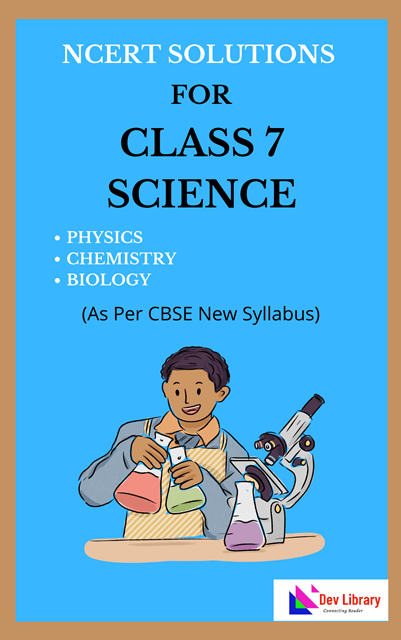NCERT Class 7 Science Chapter 9 Life Processes in Animals Solutions to each chapter is provided in the list so that you can easily browse through different chapters NCERT Class 7 Science Chapter 9 Life Processes in Animals and select need one. NCERT Class 7 Science Chapter 9 Life Processes in Animals Question Answers Download PDF. NCERT Class 7 Science Solutions.
NCERT Class 7 Science Chapter 9 Life Processes in Animals
Also, you can read the NCERT book online in these sections Solutions by Expert Teachers as per Central Board of Secondary Education (CBSE) Book guidelines. CBSE Class 7 Science Solutions are part of All Subject Solutions. Here we have given NCERT Class 7 Science Solutions and Textbook for All Chapters, You can practice these here.
Life Processes in Animals
Chapter: 9
Page No – 123
Table 9.1: Action of saliva on starch.
| Test tube | Initial colour before adding iodine | Final colour after adding iodine | Possible reason for the change in colour, if any |
| A: Boiled rice | |||
| B: Chewed boiled rice |
Ans:
| Test tube | Initial colour before adding iodine | Final colour after adding iodine | Possible reason for the change in colour, if any |
| A: Boiled rice | White or off-white | Blue-black | Presence of starch in boiled rice reacts with iodine to give blue-black colour. |
| B: Chewed boiled rice | White or off-white | No colour change / Slight yellow | Saliva contains enzyme salivary amylase which breaks down starch into sugar, so iodine doesn’t react |
| Let Us Enhance Our Learning |
1. Complete the journey of food through the alimentary canal by filling up the boxes with appropriate parts—
Ans: Food → Mouth → Oesophagus → Stomach → Small Intestine → Large Intestine → Anus.
2. Sahil placed some pieces of chapati in test tube A. Neha placed chewed chapati in test tube B, and Santushti took boiled and mashed potato in test tube C. All of them added a few drops of iodine solution to their test tubes — A, B, and C, respectively. What would be their observations? Give reasons.
Ans: In test tube (A) Neha placed chewed chapati The chapati pieces turn blue-black in color.Chapati contains starch, and iodine reacts with starch to give a blue-black color. Since the chapati is not chewed or digested yet, the starch remains unbroken.
In test tube (B) The color change to blue-black is less intense or may be absent. Chewing begins digestion of starch in the mouth with the help of the enzyme salivary amylase, which breaks starch down into sugars (maltose). Sugars do not react with iodine, so the starch content is reduced or absent, leading to little or no blue-black color.
In Test Tube (C) Santushti boiled and mashed potato The mashed potato turns blue-black.Potato also contains a high amount of starch, and boiling or mashing doesn’t break it down chemically. Iodine reacts with the starch present, resulting in a blue-black color.
3. What is the role of the diaphragm in breathing?
(i) To filter the air.
(ii) To produce sound.
(iii) To help in inhalation and exhalation.
(iv) To absorb oxygen.
Ans: (iii) To help in inhalation and exhalation.
4. Match the following.
| Name of the part | Functions |
| (i) Nostrils | (a) fresh air from outside enters |
| (ii) Nasal passages | (b) exchange of gases occurs |
| (iii) Windpipe | (c) protects lungs |
| (iv) Alveoli | (d) tiny hair and mucus help to trap dust and dirt from the air we breathe |
| (v) Ribcage | (e) air reaches our lungs through this part |
Ans:
| Name of the part | Functions |
| (i) Nostrils | (a) fresh air from outside enters |
| (ii) Nasal passages | (d) tiny hair and mucus help to trap dust and dirt from the air we breathe |
| (iii) Windpipe | (e) air reaches our lungs through this part |
| (iv) Alveoli | (b) exchange of gases occurs |
| (v) Ribcage | (c) protects lungs |
5. Anil claims to his friend Sanvi that respiration and breathing are the same process. What question(s) can Sanvi ask him to make him understand that he is not correct?
Ans: Sanvi can explain to Anil that breathing and respiration are not the same by asking him thoughtful questions like, “Does breathing produce energy?” or “Can our body cells get energy from food just by breathing?” These questions help clarify that breathing is the physical process of inhaling oxygen and exhaling carbon dioxide, while respiration is a chemical process that takes place inside the cells, where oxygen is used to break down glucose and release energy. So, while breathing is essential to supply oxygen for respiration, it does not itself produce energy. Through such questions, Sanvi can help Anil realize that respiration and breathing are related but distinct processes..
6. Which of the following statements is correct and why?
Anu: We inhale air.
Shanu: We inhale oxygen.
Tanu: We inhale air rich in oxygen.
Ans: Tanu: We inhale air rich in oxygen because the air we inhale is a mixture of gases, which includes about 21% oxygen, 78% nitrogen, and small amounts of other gases like carbon dioxide, argon, and water vapor. So, we do not inhale pure oxygen, but rather air that contains oxygen.
7. We often sneeze when we inhale a lot of dust-laden air. What can be possible explanations for this?
Ans: We often sneeze when we breathe in air filled with a lot of dust because sneezing is our body’s natural way of protecting us. The tiny hairs and mucus inside our nose try to trap the dust and keep it from going into our lungs. But when there’s too much dust, our nose gets irritated, and the body reacts by making us sneeze. Sneezing helps throw out the dust and clean our nose so that we can breathe properly again.
8. Paridhi and Anusha of Grade 7 started running for their morning workout. After they completed their running, they counted their breaths per minute. Anusha was breathing faster than Paridhi. Provide at least two possible explanations for why Anusha was breathing faster than Paridhi.
Ans: Anusha was breathing faster than Paridhi after their morning run, and there could be a couple of reasons for this. One possible explanation is that Anusha might not be as physically fit as Paridhi. When someone is less fit, their body requires more effort to supply oxygen to the muscles during physical activity, leading to a faster breathing rate. Another reason could be that Anusha might have run faster or exerted more effort during the workout compared to Paridhi. This would increase her body’s demand for oxygen, causing her to breathe faster in order to supply her muscles with the oxygen needed for recovery.
9. Yadu conducted an experiment to test his idea. He took two test tubes, A and B, and added a pinch of rice fl our to the test tubes, half f i lled with water and stirred them properly. To test tube B, he added a few drops of saliva. He left the two test tubes for 35–45 min. After that, he added iodine solution into both the test tubes. Experimental results are as shown in Fig. 9.15. What do you think he wants to test?
Ans: Yadu’s experiment, illustrated in Figure 9.15, was designed to explore the effect of saliva on starch. He prepared two test tubes, A and B, each containing rice flour mixed with water, as rice flour is a rich source of starch.To test tube B, Yadu introduced a few drops of saliva, anticipating its potential to alter the starch. Both test tubes were then left undisturbed for approximately 35 to 45 minutes, allowing time for any enzymatic reactions to occur. In the Test tube A Contains rice flour and water. Rice flour is primarily composed of starch. When iodine solution is added, it turns a dark blue-black color, indicating the presence of starch. In the Test tube B: Contains rice flour, water, and saliva. Saliva contains the enzyme salivary amylase, which breaks down starch into simpler sugars. After allowing time for the enzyme to act, the addition of iodine solution results in a light brown or yellowish color indicating the absence or significant reduction of starch.This outcome strongly implies that the saliva added to test tube B caused the breakdown of starch into simpler sugars, which do not produce the blue-black color with iodine. Consequently, Yadu’s experiment effectively demonstrates the digestive action of saliva on starch.
10. Rakshita designed an experiment taking two clean test tubes, A and B and filled them with lime water as shown in the figure. In test tube A, the surrounding air that we inhale was passed on by sucking air from the pipe, and in test tube B, the exhaled air was blown through the pipe (Fig. 9.16). What do you think she is trying to investigate? How can she confirm her findings?
Ans: In Rakshita’s cleverly designed experiment, as depicted in Figure 9.16, the objective appears to be to compare the carbon dioxide content of inhaled and exhaled air. She set up two test tubes, A and B, both filled with clear lime water, a known indicator for the presence of carbon dioxide. In the test tube A The lime water might show a slight change, possibly turning slightly milky after a longer duration of sucking in air. This would indicate the presence of some carbon dioxide in the inhaled air, although in a relatively low concentration.In Test tube B The lime water should turn significantly milky or cloudy much faster compared to test tube A. This would strongly suggest that the exhaled air contains a considerably higher concentration of carbon dioxide than the inhaled air. By comparing the extent and speed at which the lime water turns milky in both test tubes, Rakshita can visually demonstrate the difference in carbon dioxide levels between inhaled and exhaled air, thus confirming her investigation.

Hi! my Name is Parimal Roy. I have completed my Bachelor’s degree in Philosophy (B.A.) from Silapathar General College. Currently, I am working as an HR Manager at Dev Library. It is a website that provides study materials for students from Class 3 to 12, including SCERT and NCERT notes. It also offers resources for BA, B.Com, B.Sc, and Computer Science, along with postgraduate notes. Besides study materials, the website has novels, eBooks, health and finance articles, biographies, quotes, and more.



